
The German Navy is the navy of Germany and part of the unified Bundeswehr, the German Armed Forces. The German Navy was originally known as the Bundesmarine from 1956 to 1995, when Deutsche Marine became the official name with respect to the 1990 incorporation of the East German Volksmarine. It is deeply integrated into the NATO alliance. Its primary mission is protection of Germany's territorial waters and maritime infrastructure as well as sea lines of communication. Apart from this, the German Navy participates in peacekeeping operations, and renders humanitarian assistance and disaster relief. It also participates in anti-piracy operations.

The Type 212A is a class of diesel-electric submarine developed by Howaldtswerke-Deutsche Werft AG (HDW) for the German Navy, and the Italian Navy where it is known as the Todaro class. It features diesel propulsion and an additional air-independent propulsion (AIP) system using Siemens proton-exchange membrane (PEM) compressed hydrogen fuel cells. The submarines can operate at high speed on diesel power or switch to the AIP system for silent slow cruising, staying submerged for up to three weeks with little exhaust heat. The system is also said to be vibration-free and virtually undetectable.

The F125 Baden-Württemberg-class frigates are a series of frigates of the German Navy, which were designed and constructed by ARGE F125, a joint-venture of Thyssen-Krupp and Lürssen. The Baden-Württemberg class is one the heaviest displacement of any class of frigates worldwide. They have replaced the Bremen class. They are primarily designed for low and medium intensity maritime stabilization operations, where they are supposed to provide sea-to-land tactical fire support, asymmetric threat control at sea and support of special forces.

U-32 (S182) is a Type 212A submarine of the German Navy, the second of her class to enter service.
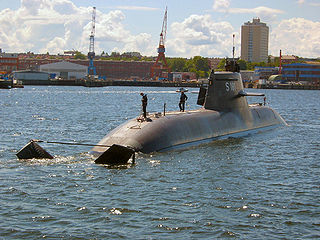
U-31 (S181) is a Type 212A submarine of the German Navy, and the lead ship of her class.

Andreas Krause is a Vizeadmiral of the German Navy of the Bundeswehr, and he served as Inspector of the Navy. He previously served as a U-boat officer, as a staff officer in the Bundeswehr and NATO, as commander of the German Navy's 1st Flotilla and the Maritime Task Force for the United Nations Interim Force in Lebanon, and as Deputy Inspector of the Navy.

U-36 (S186) is a Type 212A submarine of the German Navy. She is the sixth ship of the class to enter service.

U-34 (S184) is a Type 212A submarine of the German Navy. She is the fourth ship of the class to enter service.

U-33 (S183) is the third Type 212A submarine of the German Navy.
Horst-Dieter Kolletschke is a retired Konteradmiral of the German Navy.

The Centre of Excellence for Operations in Confined and Shallow Waters is an international military organization founded to support NATO's transformation program. As part of the NATO Centres of Excellence programme the COE CSW was established in April 2007 and officially accredited by NATO on 26 May 2009. It is co-located with the staff of the German Einsatzflottille 1 in Kiel whose commander is double-hatted as COE CSW Director.

Hamburg is a Sachsen-class frigate of the German Navy.

Brandenburg is a Brandenburg-class frigate of the German Navy, and the lead ship of her class.
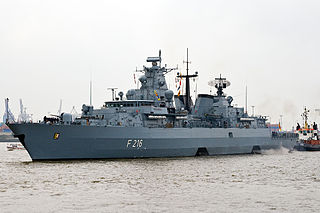
Schleswig-Holstein is a Brandenburg-class frigate of the German Navy.

Bayern is a Brandenburg-class frigate of the German Navy.
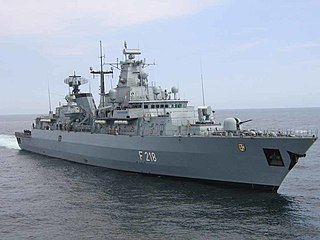
Mecklenburg-Vorpommern (F218) is a Brandenburg-class frigate of the German Navy.
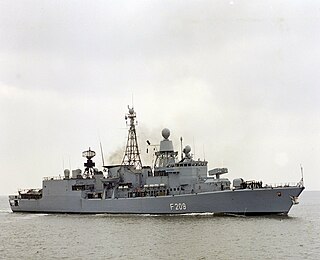
Rheinland-Pfalz was a Bremen-class frigate of the German Navy.

Augsburg is a Bremen-class frigate of the German Navy. The vessel was laid down in April 1987 by Bremer Vulkan, in Bremen, Germany and launched on 17 September 1987. The vessel was commissioned on 3 October 1989. The ship has been deployed as part of Operation Enduring Freedom – Horn of Africa and Operation Atalanta in the Middle East and Indian Ocean and has seen service in the Mediterranean Sea. The vessel is currently based at Wilhelmshaven, Germany.
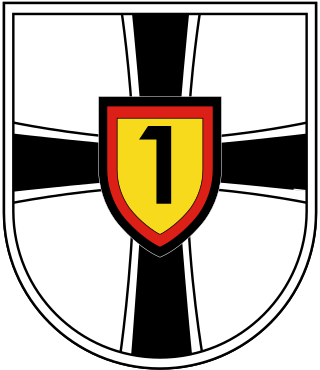
Einsatzflottille 1 is one of the three brigade-level units of the German Navy, in addition to Einsatzflottille 2 and the Naval Air Command. It is based in Kiel, Schleswig-Holstein, and is under the head of the Navy Command, based in Rostock.

The European Union Naval Force Mediterranean Operation IRINI was launched on 31 March 2020 with the primary mission to enforce the United Nations arms embargo to Libya due to the Second Libyan Civil War. Operation IRINI is a European Union military operation under the umbrella of the Common Security and Defense Policy (CSDP). The operation is expected to use aerial, maritime and satellite assets.


















